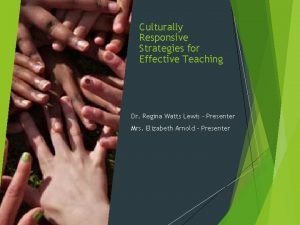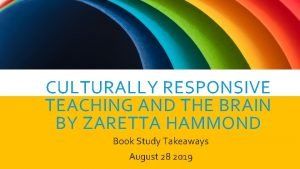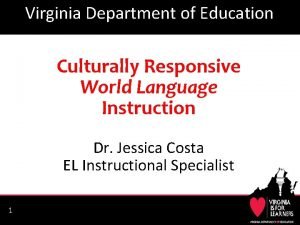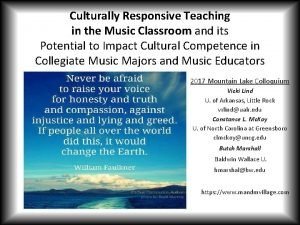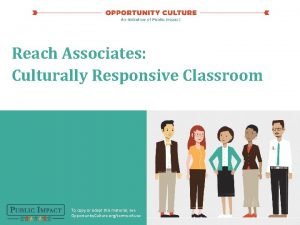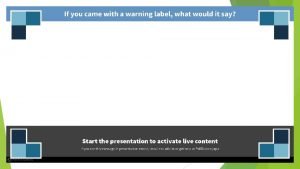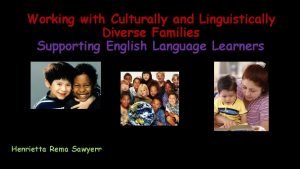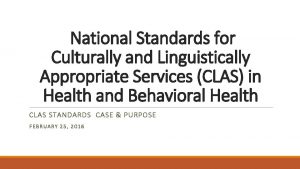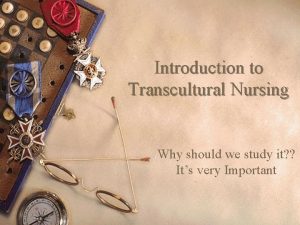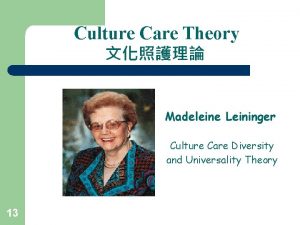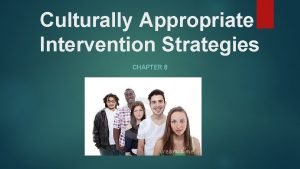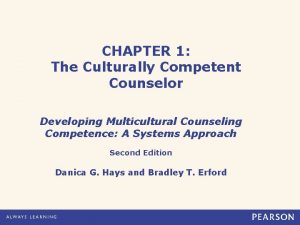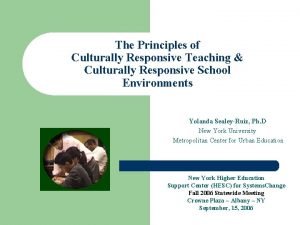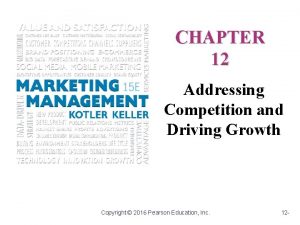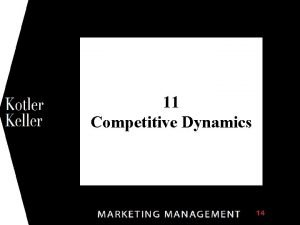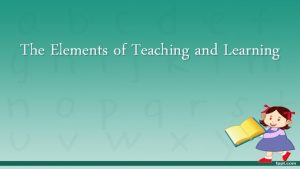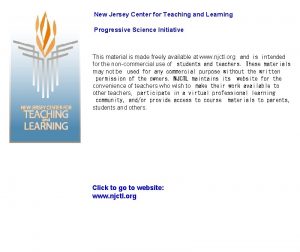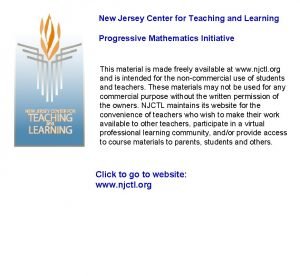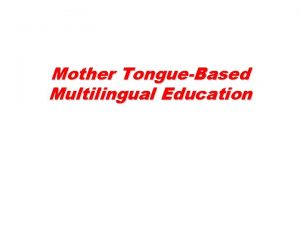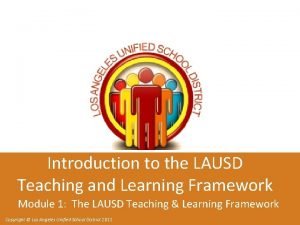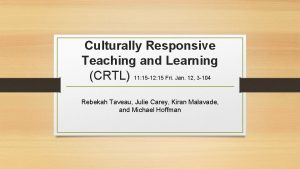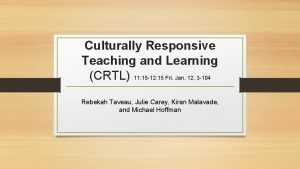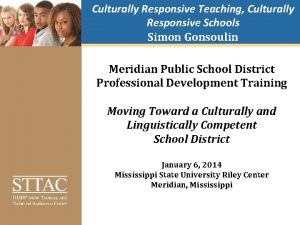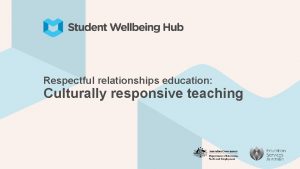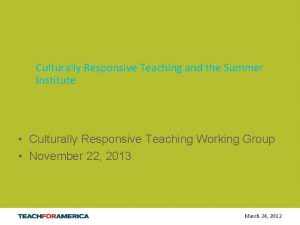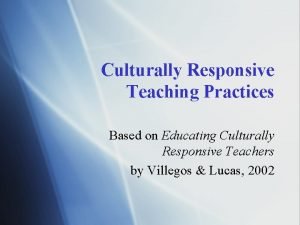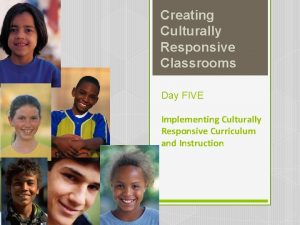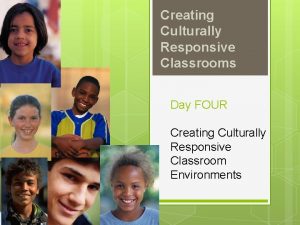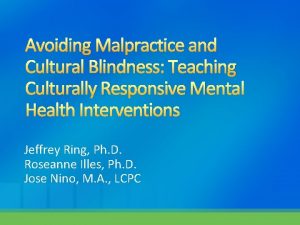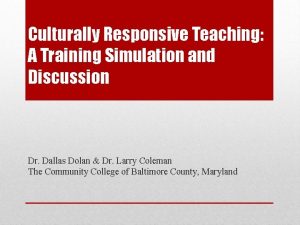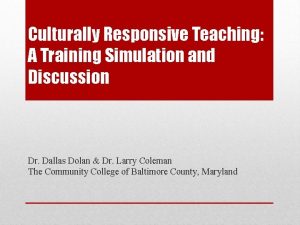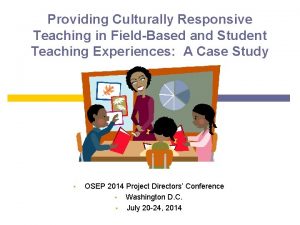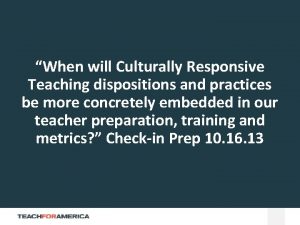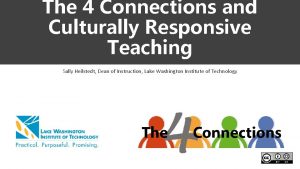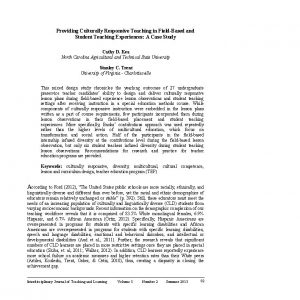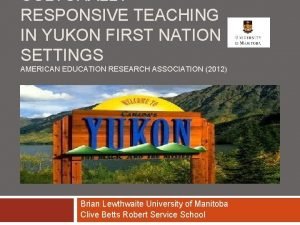Culturally Responsive Teaching and Learning CRTL 11 15






















- Slides: 22

Culturally Responsive Teaching and Learning (CRTL) 11: 15 -12: 15 Fri. Jan. 12, 3 -104 Rebekah Taveau, Julie Carey, Kiran Malavade, and Michael Hoffman

Agenda • Discuss key aspects of the CRTL definition • View examples from: • ESL • English • Math • Apply: How can you use these ideas to your classes? https: //www. eou. edu/ccrp/ Image from:

Note about the Name • • • Original Term: Culturally Responsive Teaching Newer version: Culturally Responsive Teaching and Learning Abbreviation: CRTL avoids confusion with Critical Race Theory (CRT) CRT recognizes inequitable distributions of power and resources in our society. It challenges Eurocentric values and prevailing systems of oppression that are often invisible but entrenched in our history (Solorzano & Yosso, 2002; 2000; Mc. Coy & Rodricks, 2015). CRTL: aware of the historic marginalization, employ a wide repertoire of CRT strategies to honor, validate, support, and create a safe place for diverse students (Kozleski, 2000).

What aspects of the CRTL Definition do you feel are most meaningful and why?

Culturally Responsive Teaching Definitions • uses “the cultural characteristics, experiences and perspectives of ethnically diverse students as conduits for teaching them more effectively” (Gay, p. 106, 2002). • “is about building the learning capacity of the individual student. ” Focuses on “leveraging the affective and the cognitive scaffolding that students bring with them. ” (Hammond, 2015)

Culturally Responsive Teachers • • Demonstrate respect and set high expectations Provide differentiated scaffolding Use student centered approaches Are knowledgeable and appreciative of student cultural values, customs, beliefs, communication styles, learning styles, assets, and contributions • Embed ethnically and culturally diverse content into their curriculum

Culturally Responsive Teachers • Critically evaluate curriculum design for misrepresentation or gaps in representation of diverse students • Build relationships with students and demonstrate caring • Create supportive, welcoming environments, places that feel socially and emotionally safe, so that students are comfortable enough taking the risks required to stretch their brains. • Continuously reflect on their actions and interactions to improve (Kozleski, 2000)

What aspects of the CRTL Definition do you feel are most meaningful and why? Image from http: //ontariomedic. ca/2016/09/27/critical-thinking/

My favorite • Continuously reflect on their actions and interaction to improve • Cultural humility “Do the best you can until you know better. Then when you know better, do better. ” (Maya Angelou) http: //supereval. com/blog/reflective-practice-theory-theoretical-framework-supereval/

CRTL in ESL: Caring about the Whole Learner • Facing historical deficit view of the learner in ESL. In your field? • CRT “Continuously reflect on their actions and interactions to improve” • Practicing self-reflective teaching • • Noticing when/where/why the breakdown happened and noting changes for next semester If we’re not sure how well a lesson or part of a lesson went, ask the students for written feedback

CRTL in ESL Examples and Resources CRT “Build relationships with students and demonstrate caring” and “Create supportive, welcoming environments, places that feel socially and emotionally safe, so that students are comfortable enough taking the risks required to stretch their brains. ” • Day one activity and diagnostic • Closing community activity CRT “Embed ethnically and culturally diverse content into their curriculum” • Guest lecture unit with Gerardo Pacheco

English: Students as Voices of Authority First day activities lesson plan • Read aloud from Talking Back: What Students Know About Teaching by the Students of Leadership High School • • Models annotation and reading strategies • Raises real-life issues relevant to CRTL & students • Diagnostic writing sample: summary & response Syllabus Activity • Reflection on past experience: drawing on their • expertise Students collaborate to add to syllabus

Building relationships with students: “Teaching with Love” • • “I defined love as a combination of care, commitment, knowledge, responsibility, respect, and trust…. When these basic principles of love form the basis of teacherpupil interaction, the mutual pursuit of knowledge creates the conditions for optimal learning. ” -bell hooks “Love” = high expectations “Love” = giving individual feedback (in writing or in person)

English: Student-Centered Classroom • • • Consider the classroom’s physical set-up, move around a lot Collaboration: student-student and student-teacher Student-led facilitations and projects • recognize their authority and have high expectations • often culture and community driven (ex: EPA gentrification) Authentic writing tasks • Ex: letters to Congress about DACA Being flexible: when issues arise, be willing to adjust

Appreciating Students’ Backgrounds: • • Adichie’s “The Danger of a Single Story” Other texts I’ve used that bring in culturally diverse perspectives-Add yours! Learning outside the classroom: events on campus, field trips, etc. Recognizing and discussing educational inequality/institutional racism and countering this with respect and high expectations

Math: Focus on Process ● Create collaborative environment focusing on thinking process (vs. getting the right answer) ○ have students share how they solve a problem, practice justifying their reasoning, and discuss possible answers ● Break down status stereotypes by focusing on diversity of solutions ● Recognize different ways to solve a problem that students from different countries or backgrounds may have learned and credit good process

Culturally Responsive Math Teacher Professor Role • Facilitator asks open ended questions and facilitates process discussions • Not always all knowing answer giver (IRC) coach Model Affective Attitudinal Domain • Publicly praises good process • Emphasizes Growth Mindset Guide

Culturally Embedded Content in Math • Use examples for word problems or concepts that students can relate to • A Mathematician Reads the Newspaper (Paulos) • Relate math concepts to everyday life: analogies, metaphors, visuals • Damned Lies and Statistics: Untangling Numbers from thebackgrounds Media, • Highlight famous mathematicians of diverse Politicians…(Best) • Highlights relevant cultural accomplishments José Ádem Mayan Zero

Reading Apprenticeship in Math Personal, social, cognitive elements of learning Example: intentionally modeling cognitive practices like reading a textbook. Take a page from a text and model by thinking aloud how you process the text, go between diagram and text, analyze how symbols relate to graphs, and words etc. Focus on surfacing strategies student might use Clip art. com

Application Which idea will you try or do more of in your classes or what other examples do you have?

What questions do you have? What points would you like to add?

References Hooks, B. (2003). “Chapter 11: Heart to Heart: Teaching with Love. ” Teaching Community: A Pedagogy of Hope. Routledge. p. 127 -138. Print. Delpit, L. (2006). Other People’s Children: Cultural Conflict in the Classroom. New Press. Gay, G. (2002). Preparing for Culturally Responsive Teaching. Journal of Teacher Education, 53(2), 106 -116. doi: 10. 1177/0022487102053002003 Kersaint, G. , Thompson D, & Petkova, M. (2009). Teaching Mathematics to English Language Learners. Kozleski, E. (2000). Seven principles for training a culturally responsive faculty. Equity Alliance. Retrieved from http: //www. equityallianceatasu. org/sites/default/files/Website_files/Culturally. Responsive. Teaching-Matters. pdf Ladson-Billings, G. (1994). The dreamkeepers: Successful teachers of African American children. Jossey-Bass. Mccoy, D. L. , & Rodricks, D. J. (2015). Critical Race Theory in Higher Education: 20 Years of Theoretical and Research Innovations. ASHE Higher Education Report, 41(3), 1 -117. doi: 10. 1002/aehe. 20021 Solorzano, D. , Ceja, M. , & Yosso, T. (2002). Critical race methodology: Counter-storytelling as an analytical framework for educational research. Qualitative Inquiry, 8(1), pp. 23 -44. Solorzano, D. , Ceja, M. , & Yosso, T. (2000). Critical race theory, racial microaggressions, and campus racial climate: The experiences of African American college students. Journal of Negro Education, 69(1/2), 60.
 Culturally responsive vs culturally relevant
Culturally responsive vs culturally relevant Culturally responsive teaching and the brain book study
Culturally responsive teaching and the brain book study Vdoe culturally responsive teaching
Vdoe culturally responsive teaching Culturally responsive teaching in music education
Culturally responsive teaching in music education Reach associates
Reach associates Classroom
Classroom Working with culturally and linguistically diverse families
Working with culturally and linguistically diverse families National culturally and linguistically appropriate services
National culturally and linguistically appropriate services Define cultural deprivation
Define cultural deprivation Campinha-bacote model
Campinha-bacote model Sunrise model of madeleine leininger’s theory
Sunrise model of madeleine leininger’s theory Culturally appropriate intervention strategies
Culturally appropriate intervention strategies Culturally competent counselor
Culturally competent counselor Pedagogy meaning
Pedagogy meaning Meaning of micro teaching
Meaning of micro teaching Cuadro comparativo de e-learning
Cuadro comparativo de e-learning Addressing competition and driving growth ppt
Addressing competition and driving growth ppt Responsive anticipation and creative anticipation
Responsive anticipation and creative anticipation Cognitive faculties of the learner
Cognitive faculties of the learner New jersey center for teaching and learning
New jersey center for teaching and learning How many total squares are there
How many total squares are there The guiding principles for teaching and learning mtb-mle
The guiding principles for teaching and learning mtb-mle Lausd teaching and learning framework
Lausd teaching and learning framework
